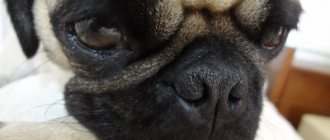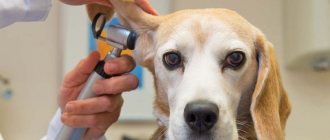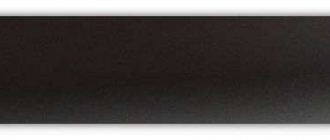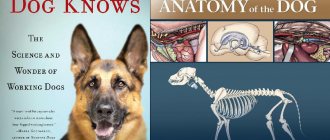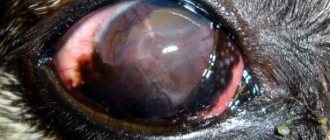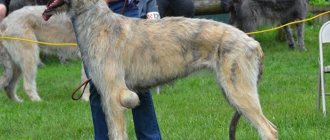Typical Pug Diseases
If the dog for some reason began to limp, although there were no injuries, aseptic necrosis of the femoral head is possible, i.e., poor circulation of the femurs. Often the disease affects both hind legs. The pug becomes inactive, reacts painfully to touching its paw, and it begins to fail. Later, the necrotic process affects the entire limb: the muscles on the affected paws dry out.
Treatment is only possible with surgery, but mobility returns soon after surgery. Pugs are genetically predisposed to such limb problems. You should act quickly before your paws give out. A problem in small dogs is necrotizing meningoencephalitis: inflammation of the central nervous system. Manifested by convulsions, involuntary movements of the pupils, paralysis. Aggressive immunosuppressive treatment is required.
A deadly disease is pug encephalitis. The animal experiences seizures similar to epilepsy, its legs give way, its head twitches, tremors and convulsions occur. Encephalitis can develop due to a tick bite, but often the cause cannot be found.
It is believed that this disease may also be hereditary. In middle-aged and elderly bitches, the uterus may become inflamed. This provokes frequent urination, severe thirst, and lethargy. Purulent discharge from the loop is possible. Urgent treatment is necessary, sometimes it is necessary to resort to removal of the uterus and ovaries.
Pugs often grunt and cough: the reason is the so-called. brachycephalic syndrome in pugs, caused by a long palate with a short muzzle. In this case, the dog may have difficulty breathing, grunting, due to heat and fatigue (pugs often begin to choke at the end of a long walk), as well as illness (runny nose, etc.). A pug often grunts when it feels happy or stressed. The tendency to this problem is also hereditary: if the parents often suffocated, the puppies will also be prone to this.
If a dog coughs as if he is choking, this is a “reverse sneeze” - the dog is trying to clear his airways. This cough can be similar to gagging, and sometimes actually turns into vomiting. Periodically, this cough occurs in many dogs with a short muzzle and goes away on its own, but if the attacks become more frequent, consultation with a specialist is necessary. The dog could either simply catch a cold or become seriously ill, including heart problems. It is also worth checking whether a choking dog has foreign objects in the nasopharynx.
Similar article: History of the appearance and characteristics of the mini-pug breed
If a pug snores, it may be a genetic trait (about 20% of pugs snore, another manifestation of brachycephalic syndrome). But if this has not happened before, the cause of snoring may be an allergic runny nose, a cold, excess weight, sleep apnea, when the dog suffocates for a moment, etc. If your pug snores with frequent choking or coughing, you should consult a veterinarian. which will tell you whether it is necessary to eliminate the allergic factor, treat a runny nose or undergo surgery.
A cough and runny nose themselves can either mean that the dog has a slight cold or be symptoms of an infection. For example, “kennel cough” occurs after contact with other dogs: exhibitions, training on the site, etc. A runny nose and sneezing, which causes snot, can occur due to allergies. One of the common causes is also rhinitis - in this case, a runny nose, if you do not take active treatment, sometimes lasts for years. In all these cases, it is necessary to contact a veterinarian.
Pug diseases and treatment
What are the most common diseases of pugs is of interest to many. These dogs are predisposed to certain health problems that require immediate treatment.
Typical diseases of pugs
Diseases of pugs are very diverse. These could be skin diseases, autoimmune diseases, infectious diseases, eye diseases, obesity, etc. In the last few years, demodicosis has become one of the most common diseases among this breed. Its causative agent is a microscopic mite. But the owner need not fear for his own health: the parasites that infect humans, cats and dogs are different.
Allergies in pugs also rank first in terms of frequency of occurrence. It can be food-related - caused by certain foods, for example, sweets, eggs, or some food components. Environmental allergies are associated with flowering plants, house dust, and flea bites. Its most common manifestations:
- the pug's eyes are watery;
- there is severe itching, redness, and nasal discharge;
- bumps and scabs form on the skin;
- the animal sleeps a lot.
Chemical allergies can be caused by flea collars, vaccines, body washes, medications, and others.
Treatment of pug allergies is similar to the principles of treating this disease in humans and other animals. First of all, the dog must be protected from contact with the allergen, but if it has not yet been identified, then it will need to be tested, according to which appropriate treatment will be prescribed in the form of medications to be taken orally and lubricated on the skin if the disease appears on the body.
Diseases of pugs associated with physiology
Some pug diseases are related to their body structure. For example, in the folds of the skin, if they are not wiped regularly, dirt can accumulate - an excellent environment for the development of bacteria.
Like all flat-faced dogs, respiratory and dental problems are common in pugs. Teeth require constant brushing to prevent the formation of tartar and protect the gums from inflammation.
We recommend reading: Your Dog Has Front Leg Cramps - Causes
If symptoms of shortness of breath and difficulty breathing appear on a hot or, conversely, cold day, it is better to take the dog home or reduce the time spent outside.
You can often hear from owners of dogs of this breed that their pug's eyes fall out. This is due to the structural features of their skull. Of course, this does not mean that when the owner comes home one day, he will find his pet’s eyeballs lying on the rug and the dog nearby. With this disease, the eyes bulge greatly and become red. The dog itself is not able to cope with the problem, so human intervention will be required. Do not try to correct the situation yourself; you need to bandage the eyes with gauze soaked in saline or salted water or a clean scarf, and in this condition take the dog to a veterinary clinic.
Obesity in Pugs
Another common and dangerous disease in pugs is obesity. It is observed with a sedentary lifestyle, unhealthy and plentiful diet. To avoid this problem, you need to carefully monitor your pet’s diet, and at the first signs of excess weight, start a diet and increase physical activity for the dog. It’s better to take care of the normal development of the pug in advance.
Shedding in pugs
Owners often complain that their pug sheds. Their coat consists of a top layer and a soft undercoat, which requires regular brushing. It is recommended to do this using a special mitten or brush. Dogs love this procedure very much, so it can be done every day. But you still cannot do without wool on the carpet even with constant grooming.
Disorders of the gastrointestinal tract in a pug
Diarrhea in a pug can occur either as a result of a serious illness or poisoning from low-quality products. If a pug is vomiting and has loose stools, then it must be constantly given water through a syringe if it refuses to do so. This will help you avoid dehydration.
It is important to take your dog for examination to a veterinarian as soon as possible, who will determine the problem and select treatment and diet.
In order for the pet to always remain healthy, it is necessary to regularly visit the veterinarian and follow the care recommendations, then the dog will always please the owner in a good mood. Vaccination, proper nutrition and walks will save you from half the problems
Obesity in Pugs
Eye diseases
Eye diseases are very common in pugs. Eyeball prolapse looks especially scary when it bulges greatly and turns red (this happens due to a blow or an insect bite). What to do in this case? Apply a damp cloth to the dog’s eye and immediately go to the hospital.
If folds of skin touch the cornea, keratitis develops: the eye turns red and ulcers appear on it. Sometimes this causes pigmentation of the cornea, i.e. pigmentary keratitis. It is treated both surgically and with drops. Pigmentary keratitis sometimes occurs due to allergies. Cataracts (the dog bumps into objects due to deteriorating vision) and conjunctivitis (inflammation of the area around the eye) often develop. All eye sores in pugs require an immediate visit to the veterinarian, as they can lead to blindness.
Related article: How many years do pugs live and how to extend your pet’s life
Eye problems: your dog’s eye is falling out – what to do?
The problem with eye loss in pugs is one of the most common and looks quite scary. It is associated with the peculiar structure of the skull and also, over time, the elasticity of the tissues is lost, which leads to the loss of the eyeball.
The most important thing for the owner is to remain calm! And then proceed to first aid:
- Calm your pet and, if possible, place the collar over his paws to prevent him from twitching and further damaging his eyes.
- Wash your hands thoroughly and disinfect to avoid infection in your eye.
- Rinse your eye with sodium chloride solution to remove dirt and dust.
- Soak a sterile gauze pad with saline solution.
- Secure the bandages to the affected area with a few wraps around the head.
After providing first aid, be sure to take your dog to the doctor! Only a specialized doctor can provide full qualified assistance to your friend!
Ear diseases
Pug diseases affecting the ears are very common. Constant scratching of the ears, their swelling, elevated temperature and lethargy of the pet, as well as mucus discharge from the ears often indicate otitis media. To avoid inflammation, your pet's ears should be cleaned regularly.
This disease can also be a consequence of a cold. Symptoms such as hot, inflamed ears, the appearance of ulcers and crusts on them are often caused by microscopic ear mites. An accurate diagnosis must be made by a veterinarian. Anti-tick medications can cause side effects and should not be used without prior consultation.
When scratching the ear, do not use iodine - it will burn the tissue. It is better to wipe the wound with brilliant green or hydrogen peroxide. An insect can get into the ears - in this case, the dog often shakes its head. To begin, lay the animal on its side and drip vegetable oil into the ear. If the insect floats up, remove it with a cotton swab; if not, contact your veterinarian, but do not try to remove it yourself, otherwise you may push it deeper.
Skin diseases
If a pug's hair is falling out, the cause may be juvenile demodicosis - a tick infection that most often attacks this particular breed of dog. In addition to progressive baldness, demodicosis in a pug leads to the appearance of ulcers, wounds, and subsequently purulent abscesses and scabs on the body. Treatment is usually comprehensive, including adjustments to diet and walking patterns to strengthen the immune system. This disease usually appears in puppies up to one year old.
Pimples in pugs are often caused by allergies. If they are red, with a dot in the center, the most likely cause is fleas. A logical question: how to remove fleas? To do this, use special shampoos, collars or sprays. The apartment should also be disinfected.
Atopic dermatitis causes itchy, inflamed areas on the face, armpits, between the toes and around the anus. Many breeds are genetically predisposed to it, but the catalysts for the disease are food allergens, pollen, house dust, etc. This disease should be treated by subcutaneous injection of the allergen in gradually increasing concentrations. All procedures are carried out exclusively in the veterinary hospital. It is important to keep the skin inside the folds clean, otherwise inflammation may occur. The muzzle especially needs such care.
Similar article: What to buy and how to make clothes for a pug with your own hands
Gastrointestinal tract dysfunction
Diarrhea in a pug can occur due to poisoning, unhealthy or unusual food, or infection. Sometimes diarrhea occurs due to nervous excitement or hypothermia. In this case, it is recommended to give the dog an enema, and until the diarrhea goes away, feed it exclusively with rolled oatmeal decoction.
If diarrhea is accompanied by vomiting, your dog should be given plenty of water or syringed to prevent dehydration. If diarrhea becomes chronic, it may be a symptom of colitis or gastritis (as evidenced by severe drooling).
Constipation often occurs due to poor diet, lack of water or a sedentary lifestyle. Sometimes constipation can be caused by an overdose of astringents during diarrhea. More dangerous causes of constipation are prostatitis and intestinal obstruction. In severe cases, treatment of constipation requires surgery. Pugs are prone to obesity. In addition to frequent constipation, excess weight aggravates breathing problems: obese pugs choke almost all the time.
Often, a pug snores due to fat folds on the neck.
If your pug is drooling a lot, it could be a sign of dental problems. Excessive salivation in transport indicates that the pet is seasick. The puppy needs to be accustomed to the car, gradually increasing the duration of the trips.
We recommend this article:
Treatment and prevention of giardiasis in dogs
Pug: health
Pug health
usually does not cause concern among owners, but there are, however, specific diseases characteristic of the breed. They can be divided into 2 groups. The first is diseases caused by the structural features and appearance of the pug (brachycephalic skull shape with large, slightly protruding eyes, skin folds). The second group is hereditary, genetically determined pug diseases.
In the photo: a pug dog
Among the hereditary diseases that threaten the health of the pug, it is necessary to highlight Perthes disease, or aseptic necrosis of the femoral head. Pug puppies become ill at the age of 4 months, lameness appears, and the puppy tries not to step on the affected limb. When the owner tries to bend or stretch his paw, the puppy experiences pain. Over time, if left untreated, the muscles begin to atrophy and the limb dries out. The diagnosis is made after an x-ray.
The treatment is surgical; the sooner it is carried out, the faster the puppy will get rid of pain and begin to move normally. Since this disease is hereditary, when purchasing a pug puppy, find out whether its parents had a similar disease. If suspicious lameness appears, you should promptly consult a veterinarian.
Dislocation of the patella (hereditary or acquired as a result of injury) occurs in pugs.
Hip dysplasia most often appears during the period of intensive growth of the pug puppy. Early signs: unsteady gait and swaying croup. Walking, slow running and swimming are useful, but intense exercise is contraindicated. The reasons have not yet been identified.
Another health problem for pugs is juvenile demodicosis. The causative agent of this disease is the microscopic acarymorphic mite Demodex canis. Many dogs have this mite on their skin, but only puppies with weakened immune systems develop demodicosis. The disease begins with thinning hair around the eyes, mouth, chest and forelimbs. The fur begins to look moth-eaten.
The sooner treatment begins, the faster and more successful the result will be. Treatment, as a rule, is comprehensive, aimed both at getting rid of the tick and at boosting immunity. If demodicosis is not treated, the disease will progress, pustules, scabs may appear, and the dog may even go completely bald.
A special area of risk for the health of pugs is the eyes, which are especially susceptible to various injuries, from being pierced by a blade of grass and foreign bodies, to the eyeball falling out of its socket due to hitting something or an insect bite. If such a situation occurs and the eye literally rolls out, you cannot try to straighten it yourself, but you need to apply a wet bandage to the injured eye and urgently take the dog to a veterinary clinic. Glaucoma is also common in pugs, which is also caused by structural features of the eye. The disease is very serious and can lead to blindness. Progressive retinal atrophy, trichiasis (growth of eyelashes at the edge of the upper eyelid in the opposite direction), and entropion of the eyelid also occur.
Pugs' facial wrinkles can also cause problems. If the fold around the eyes grows excessively, chronic keratitis can develop, which can lead to blindness. In such cases, in order to avoid dramatic consequences, the pug has to undergo plastic surgery to remove excess folds. The folds themselves also require systematic care. In its absence, inflammation may develop.
Pugs have a narrow ear canal, and as a result of this structural feature, otitis media is common. For prevention purposes, it is necessary to regularly clean your ears.
Common health problems for pugs include cleft palate and cleft lip. This is not a hereditary disease. It is caused by excessive administration of steroids to the expectant mother, a violation of her vitamin A level, or experienced stress.
Acquired or hereditary hermaphroditism may occur. External factors: diseases of the pregnant bitch, giving her anthelmintic or hormonal drugs during this period, vaccination.
Encephalitis has become the scourge of modern pugs. As a rule, it appears between the ages of 9 months and 4 years. The most common symptom is convulsions. The dog behaves strangely, the muscles tremble, and then the limbs become stiff, and the animal falls. Convulsions resembling an epileptic seizure are possible. After this, the dog falls into prostration for several hours and may temporarily lose sight. Unfortunately, no treatment has been developed.
Due to their short muzzle, pugs begin to lose teeth quite early.
There may be problems with breathing, and problems with thermoregulation can lead to overheating when exposed to heat and stuffiness for a long time.
An elongated soft palate affects the pug's vocal apparatus and leads to respiratory failure, hyperventilation and collapse. Possible surgery.
Tracheal collapse is a hereditary defect in pugs. Symptoms: hoarse breathing, barking (bubbling) cough. It is necessary to strictly control the weight of such dogs.
Pugs usually have a good appetite, their metabolism is somewhat slow, and obesity begins with excess feeding and lack of physical activity. Therefore, caring for your pug’s health should include a balanced diet, walks and active games.
Urolithiasis disease
Signs of urolithiasis are as follows: the dog urinates frequently, the urine becomes cloudy, sometimes with pus. The animal becomes lethargic and apathetic, often licking its genitals. May urinate at home. In this case, treatment is necessary, since it is very difficult to wean a sick dog from peeing at home. First, diuretics are prescribed; further treatment depends on the size and nature of the stones. Surgery is often necessary.
